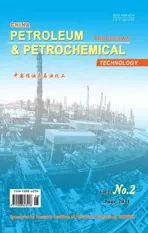Co-Ce-Ni Ternary Metal Oxide Modified N-activated Carbon:The Superior Low Temperature NH3-SCR Performance
2021-06-29WangPeiLiYuanLiuJunLiuXiaoqingTanYingxinZhangYongfa
Wang Pei†; Li Yuan†; Liu Jun; Liu Xiaoqing; Tan Yingxin; Zhang Yongfa
(1. School of Environmental and Safety Engineering, North University of China, Taiyuan 030051;2. College of Chemistry and Chemical Engineering, Taiyuan University of Technology, Taiyuan 030024;3. Beijing Institute of Mechanical Equipment, Beijing 100854)
Abstract: Introducing reduced metal and nitrogen species is a powerful strategy to improve the reactivity of carbon-based materials for selective catalytic reduction of NOx with NH3. To further improve the NH3-SCR performance of non-pitch coal activated coke (NPAC), a series of metal oxides (e.g., Co, Ce, and Ni) were loaded on nitrogen modified NPAC. The outstanding performance of NPAC-N-CoCeNi as well as the superior SO2- and H2O-tolerate performance are attributed to the extra electrons caused by the modification of N species, and these extra electrons are more conducive to the electron transfer. More importantly, the interaction of the major active component Co3+ and the promoter catalysts CeO2, NiOx, or CoNiO2 can also increase the charge transfer and produce more oxygen vacancy and unsaturated chemical bonds, leading to improving the redox performance of NPAC-N-CoCeNi. In addition, the NH3-SCR reaction is promoted after the metal oxides co-doping mainly via the Mars-van-Krevelen mechanism.
Key words: non-pitch coal activated coke; nitrogen modification; metal oxide; loading; NH3-SCR
1 Introduction
The large-scale emission of nitrogen oxides (NOx) results in the problem of photochemical smog, acid rain, haze,etc.[1]Selective catalytic reduction of NOxwith NH3(NH3-SCR) has been widely applied to eliminate the generated NOxfrom stationary and mobile combustion sources using commercial V2O5-WO3/TiO2catalyst[2].However, the high cost, toxicity, and poor SO2-resistance of V2O5-WO3/TiO2catalyst would inhibit its further development in the industrial field[3]. Therefore,the design of highly efficient and low-cost NH3-SCR catalyst is necessary and important for the denitrification technology. Activated carbon/coke has been confirmed as a superior support or catalyst for low-temperature desulfurization and denitrification due to its large specific surface area, rich porous structure and adjustable physicochemical properties. Especially in the NH3-SCR field,activated carbon/coke also exhibits superior anti-toxicity.Furthermore, the activated carbon/coke can also be modified by introducing functional groups to regulate the surface acidity and alkalinity and to further enhance its catalytic activity. It also should be noted that the activated carbon/coke is usually obtained from the commonly used coal tar pitch binder which would bring about serious pollution to the environment, thereby leading to limiting its application[4]. However, the new non-pitch binder is environmentally friendly which can be used to replace the traditional coal pitch binder to obtain the activated carbon/coke.
As mentioned above, directional control of surface functional groups can optimize the surface acidity and alkalinity of the activated carbon/coke catalyst, improving the ability of NO and NH3adsorption, and enhancing the catalytic efficiency[5]. In detail, nitrogen-containing functional groups can be introduced through two ways.On the one hand, carbon materials can be post-treated in nitrogen-containing reagents such as urea, ammonia,melamine, pyridine, or the mixed nitrogen-containing reagents, etc. On the other hand, nitrogenous reagents can be added before the preparation of carbon materials, such as treatment of these materials with certain proportion of ammonia gas during the carbonization or activation process. For example, Grzybek[6]compared the low temperature NH3-SCR activity of activated carbon with different N introducing method, and found that the SCR activity of activated carbon treated with urea was higher than that one treated with ammonia, which was promoted by the enhanced alkalinity along with strong adsorption and oxidation ability of NO. Bashkova and Bandosz[7]studied the performance for removal of NO2on ureamodified and heat-treated wood-derived activated carbon.The results have shown that the adsorption of NO2by activated carbon can be enhanced after urea treatment due to the generated NO3and NO2species. Muniz[8]studied the NH3-SCR activity of ACF treated by NH3purge. The experimental results showed that ammonia treatment could lead to the blockage of micropores and reduction of the BET area, but ammonia treatment would increase the nitrogen-containing groups of ACF, thus enhancing its catalytic activity. Besides the carbon materials,the nitrogen activation strategy can also be applied in the oxide catalyst. Li[9]studied the low-temperature denitrification activity of N-doped TiO2, and the results showed that the N doping method improved the SCR activity of N-doped TiO2catalyst through increasing the formation of surface oxygen vacancy. Based on the above discussion, it is believed that the nitrogen activation is an effective strategy for improving NH3-SCR performance of activated carbon/coke catalyst. However, there are few reports on the effect of nitrogen-containing functional groups on the denitrification activity of activated carbon/coke.
Meanwhile, except for the nitrogen activation, the introduction of metal component into activated carbon/coke can also promote the improvement of NH3-SCR catalytic performance. For instance, CeO2has been widely used as catalyst or active metal in the lowtemperature NH3-SCR due to its superior oxygen storage capacity, and the mutual transformation between Ce4+and Ce3+and abundant oxygen vacancy[10]. Moreover, upon loading CeO2onto the modified FeMnOx, the obtained catalyst also exhibited a remarkable catalytic activity and sulfur resistance at low temperature[11]. Meanwhile, the doping of Ce in Mn/TiO2could also effectively improve the denitrification rate of low temperature NH3-SCR reaction process[12-13]. Not only the rare earth oxides,but also the transition metal oxides were also reported to possess superior ability for the NH3-SCR reaction.Specifically, Wang’s study[14]showed that CoOxis conducive to the formation of porous network structure of MnCoOxcatalyst, so that the catalyst has a larger specific surface area and can provide more active sites to enhance the catalytic performance of NH3-SCR. In addition, Si[15]studied that Ni doping on the catalyst of CeO2-ZrO2can increase the Lewis acidity level and further improve the low-temperature NH3-SCR activity.
Based on the above discussion, it is acknowledged that the nitrogen activation and active metal introduction are effective for the NH3-SCR reaction over the activated carbon/coke material. In this work, we took melamine as the nitrogen source for modification of the non-pitch coal-based active coke, and CoCeNi composite oxide was loaded on the nitrogen activated active coke to prepare an effectively low temperature denitrification catalyst. Low temperature N2adsorption, XRD, XPS, NH3-TPD, and FTIR techniques were carried out to analyze the physicochemical properties of the obtained denitrification catalyst. Combined with the analysis outcome and the catalytic performance, the reaction mechanism taking place at low temperature over this catalyst was investigated. Meanwhile, the influence of calcination condition, NH3/NO ratio, and tolerance of SO2and H2O on the denitrification performance of NPAC-N-CoCeNi catalyst were systematically investigated. It is believed that this work can guide the development of carbon-based NH3-SCR catalyst in the industrial field.
2 Experimental
2.1 Preparation of NPAC
The process for preparation of non-pitch-based active coke (NPAC) is shown in Scheme 1. According to previous study[16], the crushed coal was firstly bound by adding 15% of non-pitch binder before extrusion forming at a pressure of 200 kN, then the fixed carbon contained in coal was subject to carbonization at 900 ℃for 90 min. Afterwards, primary NPAC was obtained by H2O activation at 880℃ for 150 min with a water vapor feeding rate of 1 mL/min. At last, the NPAC was obtained through oxidation and sieving process.
2.2 Preparation of NPAC-N-CoCeNi
NPAC was accurately weighed and impregnated in HNO3(with a mass fraction of 25%) solution under stirring at 80 ℃ for 1 h, and afterwards was dried at 120 ℃ for 24 h. Meanwhile, a certain amount of above-mentioned NPAC was impregnated in an 80% ethanol suspension(100 mL) containing 20 g of melamine under vigorous stirring at room temperature for 5 h. Then the mixed solution was dried at 120 ℃ for 12 h, and the generated product was subject to calcination at 700 ℃ for 2 h under N2atmosphere to obtain the nitrogen-modified NPAC(labeled as NPAC-N).
Next, the catalyst samples were prepared by the incipient wetness impregnation method over NPAC-N supports.Typically, a certain mass of NPAC-N was impregnated in the precursor solution (Ce(NO3)3·6H2O, Co(NO3)3·6H2O,and Ni(NO3)2·6H2O solution) at room temperature for 12 h. Then the obtained slurry was aged at 50 ℃ for 12 h,followed by drying for 6 h at 110 °C and calcination in N2atmosphere at 500 °C for 1.5 h. After being cooled down to room temperature, the catalyst samples were obtained and labeled as NPAC-N-CoCeNi.
The nomenclature of catalyst is (NPAC-N)1-n(CoxCeyNiz)n,in whichnrepresents the molar ratio of (Co+Ce+Ni)in the NPAC-N-CoCeNi,xrepresents the molar ratio of Co/(Co+Ce+Ni),yrepresents the molar ratio of Ce/(Co+Ce+Ni),zrepresents the molar ratio of Ni in Co+Ce+Ni.
2.3 NPAC-N-CoCeNi denitrification performance evaluation
The low-temperature NH3-SCR denitrification performance of NPAC-N-CoCeNi was evaluated in a fixed-bed reactor. The quartz tube with an inner diameter of 15 mm was used as a fixed bed reactor, as shown in Schene 2. A certain amount of the samples was placed in a constant temperature zone in the middle of the reactor.The reaction temperature was controlled by temperature programming from 90 °C to 250 °C with a temperature increase rate of 3 °C/min. The simulated flue gas was mixed by a mixer prior to entering the reactor for lowtemperature NH3-SCR reaction.
The flow chart of the experiment is shown in Scheme 2.During the experiment, 20 mg of the NPAC-N-CoCeNi were placed in the equipment under a flow of simulated flue gas (with the flue gas composition shown in Table 1).The NOxconcentration at the inlet and outlet of reactor was measured by a flue gas analyzer (MRU GmbH).Under the corresponding temperature, the NOxconversion rate is calculated by the following equation (1)
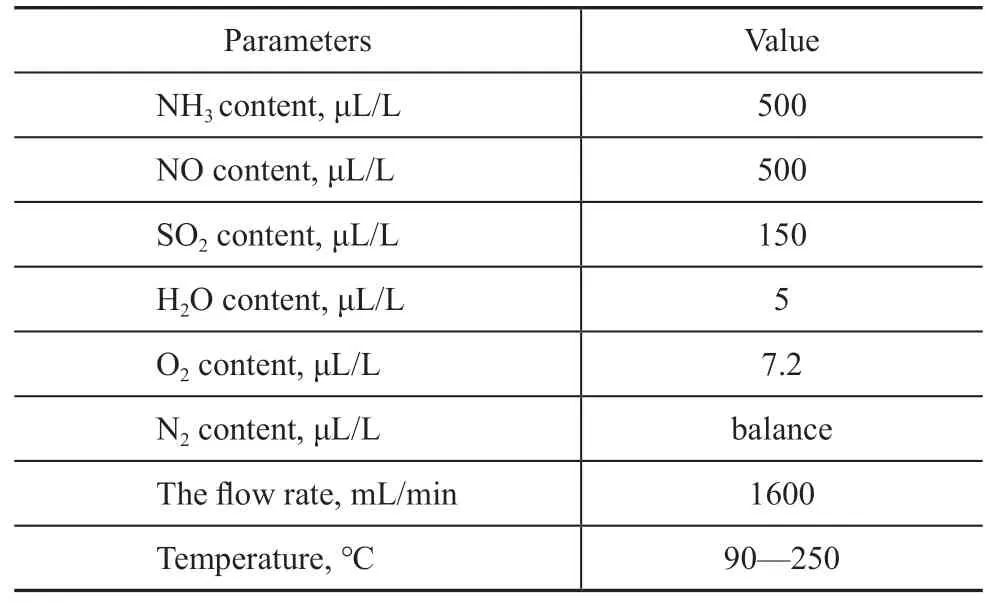
Table 1 The test conditions of the samples

Scheme 1 Preparation process of non-pitch-based active coke
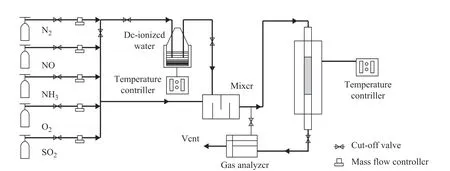
Scheme 2 Experiment device used in low temperature NH3-SCR reaction

where,ηis the denitrification rate,%;[NOx]inis the volume flow of NOxat the inlet, m3/s;[NOx]outis the volume flow of NOxat the outlet, m3/s.
2.4 Characterization
The structure of all samples was characterized by X-ray power diffraction (XRD) on a Rigaku DMAX2500 X-ray diffractometer using a copper target with Cu Kα radiation at a tube voltage of 40 kV and a tube current of 40 mA.The XRD patterns were collected at a scanning angle (2θ)range of 5°–85° with a scanning rate of 1(°)/min.
The specific surface areas were determined from the nitrogen adsorption-desorption data at liquid nitrogen temperature by using the Brunauer–Emmett–Teller (BET)technique on a Micromeritics ASAP 2020 surface area and porosity analyzer.
X-ray photoelectron spectroscopy (XPS) measurements were performed on a Thermo ESCALAB 250 with Al Kα (1486.6 eV) line at 150 W. To compensate for surface charge effects, the binding energy was calibrated using the C1s peak at 284.60 eV as the reference, the Casa XPS processing software was used to realize the quantification of the elements.
The Fourier transform infrared (FT-IR) spectra were recorded on a Nexus870 instrument with 1 mg of pure sample and 100 mg of KBr. The detector had a scanning range of 4 000 — 400 cm-1, a resolution of 8 cm-1, and a scanning frequency of 8.
NH3-TPD experiment was carried out on a gas chromatograph (7820A, Agilent). The test conditions were as follows: 0.1 g of CoCeNi-N-NPAC was pretreated at 400 ℃ under He atmosphere for 1 h to remove the adsorbed gas on the surface, and then was cooled to room temperature for adsorbing NH3until an equilibrium was reached. Finally, the sample was heated up to 120 ℃ to remove the physically adsorbed NH3, and the temperature was increased to 650 ℃ at a heating rate of 10 ℃/min.
3 Results and Discussion
3.1 Denitrification performance of NPAC-N-CoCeNi
3.1.1 Optimization of metal components amounts
Figure 1(a) shows the effect of CoOxcontent on the denitrification activity of NPAC-N-CoCe. Obviously,the denitrification rate of NPAC-N-CoCe increased from 45.35% to 50.15% as the molar ratio of Co/(Co+Ce)increased from 0 to 0.7 in a duration of 150 min, and then slightly decreased to 49.35% with a further increase of Co/(Co+Ce) molar ratio, which indicated that CoOxmodification could promote the reaction to a certain extent. The denitrification performance of (NPACN)0.95(Co1Ce0Ni0)0.05and (NPAC-N)0.95(Co0.7Ce0.3Ni0)0.05showed almost no difference, and both of them exhibited nearly an 100% denitrification performance in 30 min.Therefore, a best catalytic performance was obtained on the (NPAC-N)0.95(Co0.7Ce0.3Ni0)0.05catalyst.
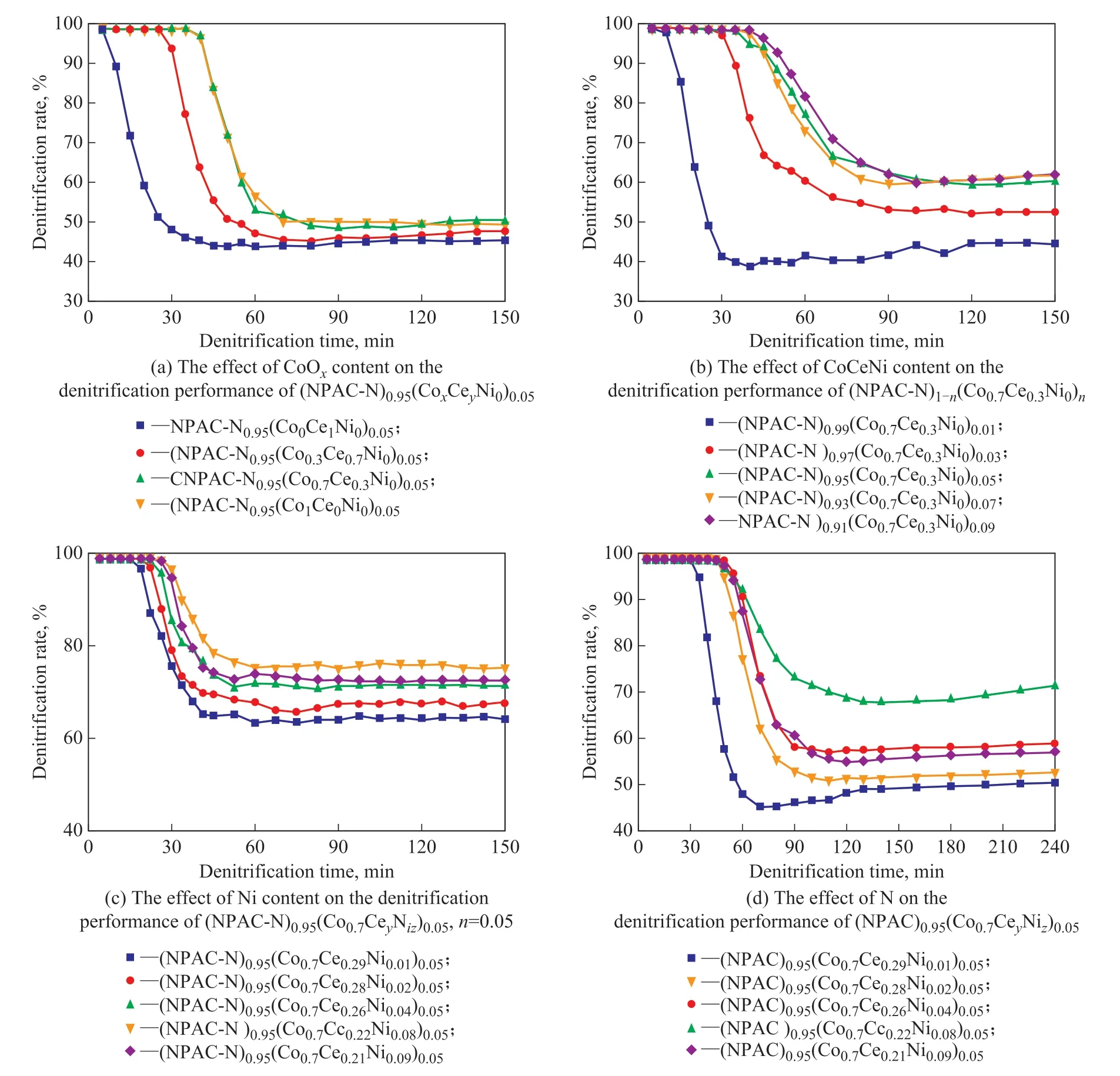
Figure 1 The effect of CoOx, CoCeNi, Ni, N on the denitrification performance
Figure 1(b) shows the effect of CoCeNi contents on the denitrification activity of NPAC-N-CoCeNi at low temperature. As the molar ratio of CoCeNi (with the optimal mass ratio of Co/(Co+Ce) determined from Figure 1(a) equating to 0.7) in NPAC-N-CoCeNi increased from 0.01 to 0.09, the low-temperature denitrification rate of NPAC-N-CoCeNi gradually increased from 44.31%to 61.89% in a time span of 150 min, which indicated that the content of CoCeNi increased the active sites on NPAC-N surface, and thereby enhanced the low temperature denitrification performance of NPAC-NCoCeNi. It should be noted that the denitrification activity of NPAC-N-CoCeNi samples remained nearly constant when the CoCeNi content exceeded 0.05. Therefore, the optimal molar ratio of Co+Ce was determined to be 0.05 for the catalytic material of (NPAC-N)0.95(Co0.7Ce0.3Ni0)0.05.To further confirm the optimal amount of Ni on the denitrification performance of (NPACN)0.95(Co0.7CeyNiz)0.05at low temperature, a test was carried out, with the results shown in Figure 1(c). Upon increasing the Ni amount from 0.01 to 0.09, the low temperature denitrification performance of NPAC-NCoCeNi first increased from 64.21% to 75.26%, and then decreased to 71.11%, and a highest denitrification rate was obtained on the (NPAC-N)0.95(Co0.7Ce0.22Ni0.08)0.05.It indicates that the addition of NiOxcontributes mostly to the improvement of denitrification activity of NPACN-CoCe at an appropriate content. Therefore, the optimum catalytic material with a highest denitrification performance was (NPAC-N)0.95(Co0.7Ce0.22Ni0.08)0.05. In addition, to verify the effect of N modification, a series of parallel experiments were conducted, with the results shown in Figure 1(d). It can be obviously seen that the corresponding activity of (NPAC)0.95(Co0.7CeyNiz)0.05was much worse than the activity of (NPACN)0.95(Co0.7CeyNiz)0.05under the same condition, which could confirm the improved effect of N modification on the NH3-SCR reaction.
In the early stage of the activity test, it was found that a high NOxconversion rate (ca. 100%) was obtained from the (NPAC-N)0.95(Co0.7Ce0.22Ni0.08)0.05catalyst, and the reaction followed the Langmuir-Hinshelwood (LH) mechanism. This might happen because the NPAC-N support could adsorb abundant NO species to react with NH3. However, after saturated adsorption of NO on NPAC, the denitrification rate decreased rapidly, and then kept a constant for a long time. In the second steady state stage, the metal oxides over the NPAC-N could take part in the NH3-SCR reaction as catalysts rather than adsorbents, and the reaction mainly followed the Marsvan-Krevelen mechanism. The similar phenomenon was also confirmed on the pitch-based ACF[17], commercial activated carbon, and sargassum activated carbon[18].Upon combining the activity results with the literature reports, it is concluded that both the N modification and active metals (Co, Ce, Ni) played key role in the NH3-SCR reaction over (NPAC-N)(CoCeNi) catalysts.
3.1.2 Optimization of preparation conditions
Not only the chemical composition, but also the preparation conditions could affect the NH3-SCR performance of (NPAC-N)(CoCeNi) catalysts. Therefore,the effects of calcination temperature and time on the catalytic performance were investigated. Figure 2(a)shows the effect of calcination temperature on the denitrification activity of (NPAC-N)0.95(Co0.7Ce0.22Ni0.08)0.05(being calcined for 1.5 h). Obviously, the denitrification activity of (NPAC-N)0.95(Co0.7Ce0.22Ni0.08)0.05increased first and then decreased with the calcination temperature increasing from 350°C to 650°C. In detail, the denitrification rate achieved at a denitrification time of 150 min increased from 65.26% to 75.45% and then decreased to 54.46%, while a highest denitrification rate was obtained on the (NPAC-N)0.95(Co0.7Ce0.22Ni0.08)0.05catalyst calcined at 500°C. In addition, the denitrification activity of (NPAC-N)0.95(Co0.7Ce0.22Ni0.08)0.05in the early stage was very close. However, the denitrification activity of (NPAC-N)0.95(Co0.7Ce0.22Ni0.08)0.05, which was calcined at higher temperature ( >500°C), did decrease due to the damaged pore structure of NPAC after being subject to high-temperature calcination and the reduced adsorption ability of NO, resulting in a lowered catalytic activity. Figure 2(b) shows the effect of calcination time on denitrification activity of (NPACN)0.95(Co0.7Ce0.22Ni0.08)0.05(being calcined at 500℃).With the increase of calcination time, the denitrification performance of (NPAC-N)0.95(Co0.7Ce0.22Ni0.08)0.05increased from 68.78% to 75.67% and then decreased to 64.58%. It can be seen that the calcination time had a great influence on the denitrification activity of (NPACN)0.95(Co0.7Ce0.22Ni0.08)0.05, and a calcination time of 1.5 h at 500 ℃ contributed mostly to the improvement of NH3-SCR catalytic performance.
3.1.3 Optimization of NH3/NO ratio in the reaction process
Except for the specific characters of (NPAC-N)0.95(Co0.7Ce0.22Ni0.08)0.05, the activity test condition could also affect its catalytic performance. Figure 3 shows the effect ofn(NH3)/n(NO) ratio on the denitrification activity of (NPAC-N)0.95(Co0.7Ce0.22Ni0.08)0.05catalyst in the NH3-SCR reaction. Clearly, the denitrification rate of(NPAC-N)0.95(Co0.7Ce0.22Ni0.08)0.05for NH3-SCR reaction increases with an increasing NH3content at lown(NH3)/n(NO) ratio (<1), which is consistent well with the previous report of Fe2O3/AC catalyst made by Yang[19].However, the NH3-SCR activity could not be improved with a further increase ofn(NH3)/n(NO) ratio, and the denitrification rate began to level off. Therefore, the(NPAC-N)0.95(Co0.7Ce0.22Ni0.08)0.05catalyst could give a highest efficiency when the optimal n(NH3)/n(NO) ratio was 1.
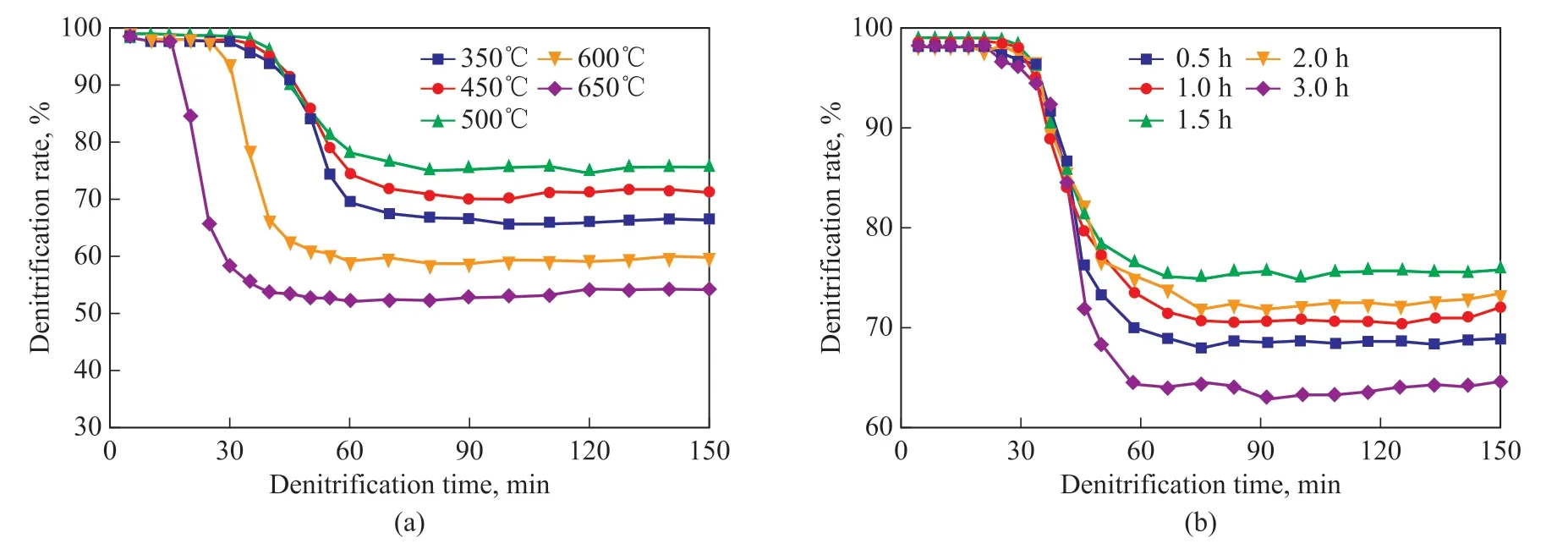
Figure 2 The effect of calcination temperature (a) and time (b) on the denitrification performance of (NPACN)0.95(Co0.7Ce0.22Ni0.08)0.05.
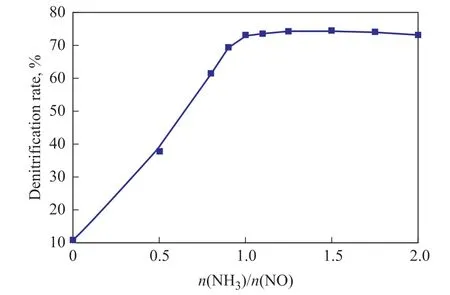
Figure 3 The effect of n(NH3)/n(NO) ratio on the denitrification performance of (NPAC-N)0.95(Co0.7Ce0.22Ni0.08)0.05
3.2 Crystal structures of the catalysts
To present the original phase of the metal oxides after loading on the NPAC, the different metal oxides were severally loaded on the NPAC as references. As shown in Figure 4(a), the NPAC itself only shows the diffraction peaks of carbon and graphite crystallites. After loading metal oxides on the NPAC, it merely displayed the(002), (100), and (101) diffraction peaks of graphite crystallites and diffraction peaks of carbon (JCPDs No.46-0943). Moreover, the phase of metal oxides of CeO2,NiO, and Co2O3was also observed, respectively. As for the NPAC-N-CoCeNi catalysts, the diffraction peaks of CeO2, Co3O4, NiO, and CoNiO2after the co-loading of multi-metal oxides are shown in Figure 4(b). Especially,with the increase of NiOxloading, the intensity of the diffraction peak of the graphite-like structure becomes weaker, indicating that some metal oxides are embedded in the graphite-like structure of NPAC. Meanwhile, the diffraction peaks of NiO become stronger as expected,which is ascribed to the aggregation of NiO crystals at high Ni loading. According to the results depicted in Figure 1, it is acknowledged that the catalytic performance of NPAC-N-CoCeNi could be improved by increaseing the CoOxamount. Upon combining the XRD results of Co3+→Co2+during the co-loading process, it is believed that Co3+can play a vital role in the NH3-SCR catalysis process. The introduction of N may produce extra electrons, which are prone to delocalization to promote the electron transfer of Co3+. Moreover, CeO2may play the role of promoter in this catalyst, and the electron transfer of Co2++Ce4+→Co3++Ce3+can make the effective component of Co3+restored to the original state,and afterwards can continue to participate in the catalytic reaction. In conclusion, the synergistic effect of N site and active metal could improve the catalytic performance.In addition, the existence of CoNiO2indicates that the combination of Ni and Co would promote more efficient electron transfer, which is also beneficial to the multielectron reaction of NH3-SCR reaction process.
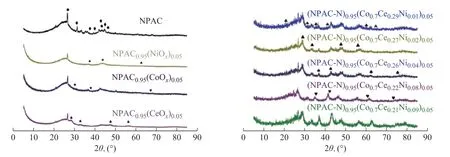
Figure 4 XRD patterns of (a) NPAC0.95(NiOx/CoOx/CeOx)0.05 and (b) NPAC-N-CoCeNi
3.3 Chemical state of the catalysts
The XPS technique was used to further explore the elements valence state of NPAC-N-CoCeNi, with the results shown in Figure 5. Firstly, the types and content of nitrogen-containing functional species on the surface of activated carbon/coke are shown in Figure 5(a) and Table 2[20]. In Figure 5(a), the deconvolutions of complex N1s spectrum are resolved into four groups and are respectively labeled as N-6, N-5, N-Q, and N-X, which are ascribed to the pyridine nitrogen, pyrrolidine, pyridine nitrogen oxides, and nitro compounds, respectively.[20]It can be obviously observed from Table 2 that the relative content of N-6 and N-5 on the surface of NPAC-N increased after nitrogen treatment, while the relative content of N-Q and N-X decreased. The outcome of N1s indicates that the nitrogen atoms could penetrate into the graphite structure of NPAC to form new stable nitrogen-containing functional species during nitrogen activation. And the introduction of N species in carbon is beneficial to enhancing the adsorption of NO to further accelerate the reaction rate[21-22]. The possible reason is that the adsorption capacity of nitrogenous carbon could be enhanced through electron transfer from the carbon surface to the NO molecule. Wang, et al.[23]reported that ammonia treatment could promote the chemical adsorption of molecular oxygen, when nitrogen atoms would replace the carbon atoms in the graphene layer, so that the extra electrons tended to delocalization and could be transferred to the reactive intermediates for adsorbing material easily, leading to finally an improved reactivity.Besides the experimental results, this conclusion has also been supported by the theoretical calculation[24].Compared with other N species, the delocalization of pyridine nitrogen plays a major role in the catalytic process of the co-loaded catalyst. This is why we mainly focused on the effect of N-6 content in the subsequent analysis.
Figure 5(b) shows the N 1s spectra of NPAC-N-CoCeNi and Table 2 summarizes the relative content of nitrogencontaining functional species on these three modified NPAC catalysts. After loading metal oxides, the relative content of pyridine nitrogen on the NPAC surface increased, and the increased pyridine nitrogen could affect the electron delocalization to promote the NH3-SCR catalytic performance.
Figure 5(c) shows the O 1s spectra of NPAC-N-CoCeNi catalysts. The fitted peak between 529.5 eV -530.1 eV is attributed to lattice O2-(Oα), and the fitted peak between 531.0 eV -531.7 eV is attributed to the adsorbed oxygen on the surface (Oβ). The fitted peak between 532.7 eV-533.5 eV could be attributed to the oxygen bound in the form of C-O(Oγ)[25-26]. Meanwhile, Table 2 summarizes the relative content of Oβ. Clearly, the Oβ/(Oα+Oβ+Oγ) ratio at first increases and then decreases with an increasing NiOxloading content, and the (NPAC-N)0.95(Co0.7Ce0.26Ni0.04)0.05possesses a highest content of chemisorbed oxygen. It is reported that the presence of chemisorbed oxygen could help NO to be oxidized to NO2, which would promote the occurrence of “fast-SCR” reaction that is in agreement with the activity result (Figure 1).
Figure 5(d) shows the Ce 3d spectra of NPAC-NCoCeNi catalysts, and the valence state of Ce in NPACN-CoCeNi is Ce3+and Ce4+, however, mostly Ce4+can be observed[27]. Furthermore, the deconvolutions of complex Ce 3d spectrum are resolved into 10 peaks, with the relative ratio of Ce3+/(Ce3++Ce4+) presented in Table 2. The (NPAC-N)0.95(Co0.7Ce0.26Ni0.04)0.05also possesses a highest Ce3+content, which is promoted by the charge transfer of Co2++Ce4+→Co3++Ce3+and is consistent well with the XRD result (Figure 4). Particularly, the change of Ce4+→Ce3+would create oxygen vacancy and unsaturated chemical bonds, thereby increasing the concentration of chemisorbed oxygen on the surface and improving the redox capacity of NPAC-N-CoCeNi.[27]

Table 2 Distribution of surface nitrogen-containing groups of the samples
Figure 5(e) shows the Co 3d spectra of NPAC-N-CoCeNi.The peak at 780.4 eV is assigned to the Co3+of Co 2p3/2,and the peak at 782.2 eV is attributed to the Co2+of Co 2p3/2, along with the satellite peak at 796.7 eV[28-29]. The characteristic peak of Co 2p1/2is identified at 796.7 eV along with the satellite peak at 802.9 eV. This result indicates that both the Co3+and Co2+can exist in NPACN-CoCeNi catalyst, and the electron transfer between Co2+and Co3+could contribute to the improvement of the denitration reaction.
Figure 5(f) shows the Ni 2p spectra of NPAC-N-CoCeNi.There are two satellite peaks in the spin orbit of Ni 2p3/2,while the main peak at 854.4 eV, coupled with the two satellite peaks at 856.2 eV and 861.7 eV, are observed[30]. The Ni 2p spectra not only indicate the presence of Ni2+and Ni3+in NPAC-N-CoCeNi, but also confirm the valence state transformation of Co2+↔Co3+, Ce3+↔Ce4+,and Ni2+↔Ni3+, which is conducive to the formation of oxygen vacancy and the transformation of NO to NO2,thereby enhancing the denitrification activity of the modified NPAC. The similar phenomenon could also be proved by previous report.[31]

Figure 5 XPS spectra of NPAC, NPAC-N and the catalyst samples
Based on the above discussion, the possible catalyst formation mechanism can be verified: (1) Co3+is the major catalytic active center, the increase of Co3+amount is beneficial to the improvement of catalytic performance; (2) As a promoter, the Ce4+ions could take part in the reaction of Co2++Ce4+→Co3++Ce3+, making the Co3+restored to the original state to participate in the catalytic reaction; (3) The Ni2+↔Ni3+involved valence state transformation and the form of new component of CoNiO2will improve the transfer of electron ability and create the oxygen vacancy. In a word, the synergistic effect of active metal of Co3+and promoter of Ce4+/Ni2+can improve the catalytic performance of NH3-SCR reaction over the NPAC-N-CoCeNi catalyst.
3.4 Textural properties
Table 3 summarizes the structural parameters of NPACN-CoCeNi. After the melamine treatment, all the specific surface area, total pore volume, and micropore volume of NPAC decreased, while the average pore size increased.This result suggests that melamine treatment can destroy the pore structure of NPAC. At the same time, the larger pore diameter could promote the exposure of active sites,which is conducive to the entry and exit of reactants and products during the catalytic process. Upon increasing the CoOx, CeOxand NiOxcontent, the specific surface area and micropore volume of NPAC-N-CoCeNi continued decreasing, while the total pore volume and average pore size increased. The change of structural parameters of NPAC-N-CoCeNi catalysts was affected by the deposition of metal oxides into the activated carbon/coke channels.Furthermore, the newly generated compounds between metal oxide and activated carbon/coke could also reduce the surface area. Combined with the activity results(Figure 1), the NPAC-N-CoCeNi catalysts could possess the highest BET surface area, but did not exhibit a best catalytic activity, suggesting that the BET surface area did not play a key role in the NH3-SCR reaction.

Table 3 Pore structure properties of NPAC-N-CoCeNi
3.5 Surface acidity
The NH3-TPD experiment was performed to gain an insight into the nature of surface acidity of the NPACN-CoCeNi catalysts, with the results shown in Figure 6.Obviously, the similar NH3-TPD desorption peaks were observed over these three modified NPAC catalysts: a weak TPD desorption peak at the low temperature and a strong peak TPD desorption peak at the high temperature,which were assigned to the weak acid/medium strong acid sites and strong acid site, respectively.[32-33]The desorption temperature of NH3on the (NPAC-N)0.95(Co0.7Ce0.22Ni0.08)0.05and (NPAC-N)0.95(Co0.7Ce0.21Ni0.09)0.05was higher than that of (NPAC-N)0.95(Co0.7Ce0.26Ni0.04)0.05, suggesting the enhanced acidic property.
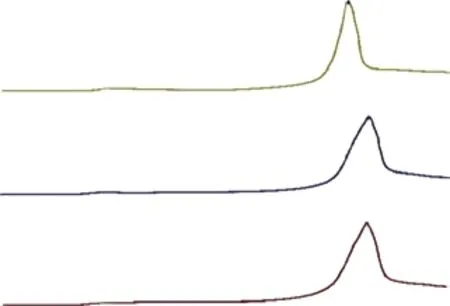
Figure 6 NH3-TPD patterns of NPAC-N-CoCeNi
3.6 Tolerance to H2O and SO2
It is well known that SO2and H2O are inevitable components under the real exhaust condition of NH3-SCR reaction,and the presence of SO2and H2O could impair the SCR catalytic efficiency and shorten the lifetime of SCR catalysts.Therefore, the SO2- and H2O-resistant test was performed over the (NPAC-N)0.95(Co0.7Ce0.22Ni0.08)0.05catalyst, with the results shown in Figure 7. The presence of 5% of H2O could result in a decrease of denitrification rate from 75.14% to 58.35% and the durability performance of H2Otolerance is stable with time. When H2O (g) was cut off,the denitrification rate of (NPAC-N)0.95(Co0.7Ce0.22Ni0.08)0.05began to recover slowly to the original level, implying that the excellent tolerance towards H2O over the NPACN)0.95(Co0.7Ce0.22Ni0.08)0.05catalyst. Wan[19]investigated the effect of H2O on the denitrification activity of MnOx/PG, and pointed out that H2O had an inhibitory effect on the SCR reaction of MnOx/PG because of the competition between H2O and NH3.Meanwhile, the presence of H2O would inhibit the oxidation of NO at low temperature, further inhibiting the occurrence of rapid SCR reaction. As for the SO2-resistant performance, it is obvious that the denitrification activity of(NPAC-N)0.95(Co0.7Ce0.22Ni0.08)0.05decreased sharply from 75.14% to 33.46% after injecting 150 ppm of SO2. After stopping the injection of SO2, the denitrification activity of(NPAC-N)0.95(Co0.7Ce0.22Ni0.08)0.05gradually recovered but to a less extent as compared to the original level (60.42%).This result indicates that SO2could cause irreversible inactivation of (NPAC-N)0.95(Co0.7Ce0.22Ni0.08)0.05, which might possibly be caused by the enhanced adsorption of SO2and alkalinity on the surface of the NPAC. Moreover, as a polar molecule, SO2could be easily adsorbed than NO onto the NPAC-N)0.95(Co0.7Ce0.22Ni0.08)0.05catalyst[34]. Therefore,SO2will occupy preferentially the active sites of the NPAC,thus reducing the denitrification activity of the modified NPAC during the denitrification process. Meanwhile, the formed H2O will also interact with SO2and NH3to form ammonium sulfate during the NH3-SCR reaction process,while depositing on the surface of the NPAC and hindering the improvement of the SCR reaction activity[34-36].
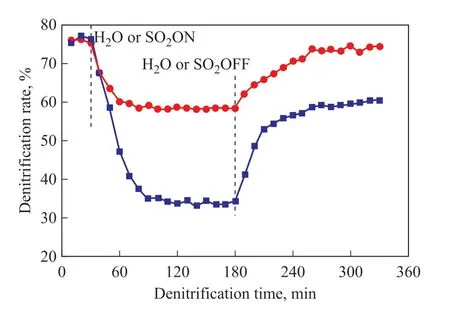
Figure 7 The effect of SO2 and H2O (g) on the denitrification performance of (NPAC-N)0.95(Co0.7Ce0.22Ni0.08)0.05

Figure 8 (a) FTIR patterns of NPAC and NPAC-N,(b) FTIR patterns of fresh and reacted NPAC-N)0.95(Co0.7Ce0.22Ni0.08)0.05
3.7 FTIR analysis
The infrared spectroscopy experiment was used to investigate the changes of surface functional groups of NPAC, NPAC-N and (NPAC-N)0.95(Co0.7Ce0.22Ni0.08)0.05.As shown in Figure 8(a), the NPAC shows an infrared absorption peak at 1120 cm-1of the imine group (-C=N-)after the melamine treatment[37], indicating that N atoms have successfully entered the NPAC surface. Compared with NPAC, the infrared absorption peak of NPAC-N at 1250 cm-1(C-N stretching vibration) is more obvious,indicating the generation of more N atoms in the structure of NPAC surface functional groups. In addition, the weak infrared absorption peak of NPAC-N at 1330 cm-1is assigned to the absorption peak of pyridine functional groups[38]. According to the above analysis, NPAC and NPAC-N are relatively rich in surface functional groups. Especially, the abundant oxygen-containing functional groups can provide the acidity of NPACN)0.95(Co0.7Ce0.22Ni0.08)0.05catalyst with NH3adsorption potential, and nitrogen-containing functional groups also show alkalinity to possess NO adsorption potential, which is beneficial to the NH3-SCR reaction.
Figure 8(b) shows the infrared spectra of (NPACN)0.95(Co0.7Ce0.22Ni0.08)0.05before and after denitrification. It can be obviously found that the vibration peak intensity of each functional group of (NPAC-N)0.95(Co0.7Ce0.22Ni0.08)0.05decreases after the reaction. Between 1 300―1 000 cm-1, the strength of the C-O stretching vibration peak of phenol,lactone, and ether decreases, indicating that these acidic groups can absorb NH3and participate in the reaction during the NH3-SCR process[16]. The intensity of the absorption peak of pyridine functional groups at 1330 cm-1decreased after denitrification, indicating that pyridine nitrogen could participate in NOx-NH3-O2reaction. In conclusion, the infrared spectroscopic analysis further proves that NPAC not only plays a supporting role, but also participates in the catalytic reaction during the whole low-temperature NH3-SCR process.
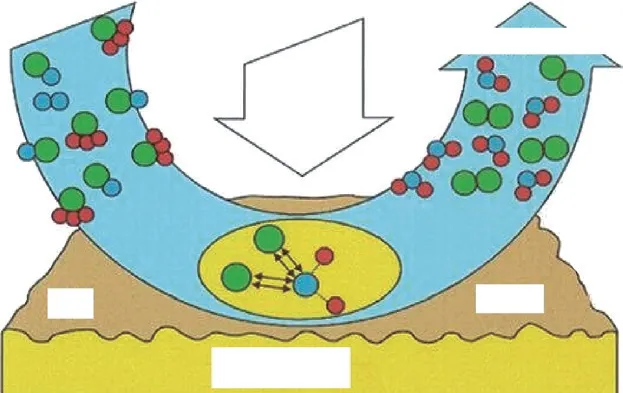
Figure 9 Illustration of possible denitrification reaction mechanism over the NPAC-N-CoCeNi catalyst
3.8 Reaction mechanism
Upon combining the catalytic activity and physicochemical properties of NPAC-N-CoCeNi catalyst, it is proposed that the reaction mechanism of the metal oxides co-doping could promote the SCR reaction by the L-H and the MvK routes. At first, the acidity of oxygencontaining functional groups produced by the metal oxides and NPAC could adsorb NH3, while the alkalinity of nitrogen-containing functional groups generated from N modification could possess the ability to capture NO.However, the reaction time of MvK mechanism was higher than the value of L-H mechanism over the catalysts,which confirmed that the MvK route played a main role in this reaction over the NPAC-N-CoCeNi catalyst. The extra electrons produced by the introduced N species are prone to delocalization, and can be easily transferred to the reactive intermediates for adsorption material to finally improve the reactivity vacancy. More importantly, the change of Ce4+→Ce3+would bring about the formation of oxygen and unsaturated chemical bonds, thereby increasing the concentration of surface chemosorbed oxygen and improving the redox capacity of NPAC-N-CoCeNi. Finally,the synergetic effect of CeO2, NiOx, and CoNiO2can contribute to the improvement of the NH3-SCR reaction.
4 Conclusions
In summary, a series of NPAC-N-CoCeNi NH3-SCR catalysts were prepared by the traditional impregnation method and were investigated for NOxremoval through NH3-SCR reaction. The activity results demonstrated that the obtained (NPAC-N)0.95(Co0.7Ce0.22Ni0.08)0.05catalyst demonstrated a superior low temperature NH3-SCR denitrification performance. However, the metal oxides loading and N modification, excluding the specific surface area and the pore volume, can contribute to a remarkable increase in activity with following reasons: (1) The N modification could produce the extra electrons, which are conducive to the delocalization and transfer of more conducive electrons. (2) The promoter of Ce4+could make the effective component of Co3+restored to the original state in order to participate in the catalytic reaction through the Co2++Ce4+→Co3++Ce3+route. Meanwhile, the transformation of Ni2+↔Ni3+and the generated CoNiO2component will improve the transfer of electron and produce the oxygen vacancy. At last, the synergistic effect of Co3, Ce4+and Ni2+together can improve the catalytic performance through enhancing surface acidity. (3)The acidity of oxygen-containing functional groups can provide the adsorption sites of NH3, while the alkalinity of nitrogen-containing functional groups can provide the adsorption sites of NO. Both the acidity related oxygencontaining functional groups and the alkalinity related nitrogen-containing functional groups can guarantee the NH3-SCR reaction by following both the L-H mechanism and the MvK mechanism. Finally, the (NPAC-N)0.95(Co0.7Ce0.22Ni0.08)0.05catalyst has a superior low temperature NH3-SCR denitrification performance and show a relatively high tolerance to H2O and SO2.
Acknowledgement:This work was financially supported by the National Natural Science Foundation of China (51901209),the Postdoctoral Science Program of China (2019M660061)and the Applied Basic Study Program of Shanxi Province(201801D221349).
杂志排行
中国炼油与石油化工的其它文章
- Effect of Acidity on Methylation of Benzene with Methanol Catalyzed by HZSM-5: A DFT Study
- Study on Reducing Injection Pressure of Low Permeability Reservoirs Characterized by High Temperature and High Salinity
- Heat Transfer and Kinetics Study of Moroccan Oil Shale Pyrolysis Process
- Application of a New Catalyst Deactivation Model for Residue Hydrotreating
- High-efficiency Extraction of Bitumen from Oil Sands Using Mixture of Ionic Liquid [Emim][BF4] and Dichloromethane
- Heat Exchanger Network Retrofit of Diesel Hydrotreating Unit Using Pinch Analysis
